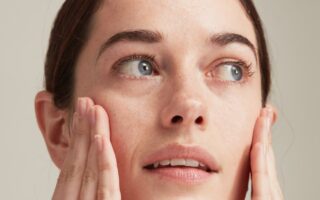The skin influences the first impression the most. Hormonal changes, especially in the first trimester of pregnancy, can cause sudden changes in skin texture. Varicose veins, stretch marks and sometimes itchy skin and fluid retention appear. Most of these changes go away naturally after delivery.
Spots and chloasma
During the second half of pregnancy, 70% of women (especially those with a dark complexion) develop diffuse, irregular brown spots on the face, called chloasma or mascara pregnancy. This is a hereditary and hormonal condition, but the sun is the main trigger.
The most prone areas are those exposed to direct sunlight, such as cheekbones, forehead, nose and chin. The best thing is to prevent stains using sun protection without alcohol. And if you have already left, avoid sunbathing and use total protection (SPF 50+). In many cases, they cannot be prevented, but sunscreen helps to keep them from being so dark. Generally, the spots improve, and in most cases, they disappear after delivery.
Skin hygiene
Use neutral and creamy soaps. Hot baths are not recommended. The shower is preferable, without limitations of number but of water temperature.
Avoid stretch marks
Stretch marks result from injuries in the deepest part of the skin when the collagen and elastin fibers of the dermis break. They appear more frequently on the belly, breasts, thighs, inner side of the arms, abdomen and hips. They are almost inevitable. During pregnancy, 70 to 90% of women develop them, but they do not compromise the woman’s health or the functioning of her body.
The beginning of stretch marks is characterized by the appearance of very thin and slightly raised reddish lines that become thicker over time. They soon become depressed and acquire a purple hue, which over the years, turns whitish, and the hair on their skin disappears. They tend to appear in the last months of pregnancy when growth is maximum. They are irreversible, so it is very important to prevent them. For this, we advise you:
• Moisturize your skin. The more elastic the skin is, the less chance there is of developing stretch marks, which is why frequent hydration of the areas most prone to stretch marks is important, giving a gentle massage with moisturizing or specific anti-stretch mark body creams to increase circulation (twice a day).
Cellulite or orange peel
Cellulite is an alteration of the connective tissue of the skin. Its most immediate manifestation is the accumulation of fat in various areas of the body, especially in the buttocks, thighs and legs during pregnancy. To prevent this aesthetic problem, we propose:
• Diet: it is not convenient to gain more than fifteen kilos during pregnancy (except in multiple pregnancies). In addition, it is convenient to have a healthy and balanced diet: reduce salt, do not abuse excessively fatty foods or sweets and drink plenty of water.
• Massages promote blood circulation and make ascending circular movements from the feet to the thighs.
• Walk for half an hour daily and make circular movements with your feet, from left to right.
• It is not advisable to stand or sit for a long time. If you have to stand, it is better to walk, even if it is short stretches. If you work sitting down, walk at least once an hour, or raise and lower your heels periodically to activate circulation in your legs.
• Avoid tight clothing. Look comfortable with loose and light clothing.
• To promote circulation, it is advisable to finish the bath or shower with a jet of cold water. Excessively hot baths are not recommended.
• The use of anti-cellulite creams is not recommended. Always consult with your gynecologist before beginning any cosmetic treatment.
Itching and hives during pregnancy
The stretching of the skin to conform to the new measurements sometimes produces an itch in the abdomen and breasts. Sometimes the palms of the hands and the soles of the hands become red, giving rise to a small itch.
However, severe itching may be a symptom of a liver problem known asintrahepatic cholestasis of pregnancy. It is a disease that can seriously affect the fetus, so at the slightest suspicion of suffering from it, it is very important to see a doctor to verify or rule out this pathology with a blood test, ultrasound and monitoring controls of the baby.
A very small percentage of pregnant women suffer from itching in the abdomen due to the appearance of hives and spots on the belly in the third trimester. This skin rash is known as itchy and urticarial papules and plaques of pregnancy. Despite that name, please do not panic; they are harmless to you or the fetus. The doctor will prescribe a cream and an antihistamine and, if necessary, treatment with steroids. The condition usually goes away after giving birth.
Hydrating creams
It is recommended to moisturize the entire body, especially the abdomen, breasts and thighs. To avoid skin irritation, use an unscented cream and wash only with mild soap. If you notice very dry skin, use creamy balm-type products, and if, on the contrary, it becomes very oily, use milk and oil-free products.
Excessive heat
Heat can intensify itching and rashes. When you go out in summer, use loose and cotton clothing, especially in the crotch area.
• If blemishes, pimples or slight redness have started to appear on your face, apply a chamomile infusion with a cotton pad to your clean face for 15 minutes. It will help “clear” your skin and acts as a calming and refreshing agent.
• Sometimes, at the end of pregnancy, the face and neck swell due to fluid retention. To reduce swelling, apply a towel soaked in cold water or a decongestant mask to your face.
Body hair
Some women develop body hair during pregnancy due to hormonal changes. It is temporary; it disappears a few months after the baby’s birth. In other cases, hair is reduced by the action of certain hormones.

